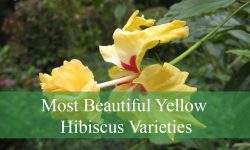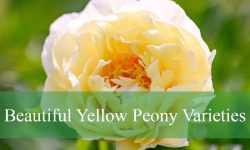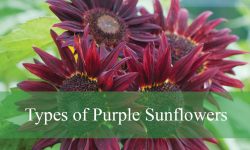When it comes to brightening up your garden, shrubs with yellow flowers offer a vibrant and cheerful touch. These plants are not only visually appealing but also versatile, adding color and texture to landscapes throughout the year. If you’re aiming to create a stunning focal point or add a pop of sunshine to your borders, shrubs with yellow flowers are an excellent choice for any garden style.
Shrubs with yellow flowers come in a wide variety of sizes, shapes, and bloom times, making them a perfect fit for both small and large gardens. From low-growing ground covers to tall, elegant specimens, these shrubs can be used in many different garden designs. Their bright yellow blooms also attract pollinators, bringing more life to your outdoor space.
In this guide, we will explore 35 stunning shrubs with yellow flowers, providing you with identification tips and pictures to help you choose the best ones for your garden.
Different Types of Shrubs with Yellow Flowers
Forsythia (Forsythia x intermedia)
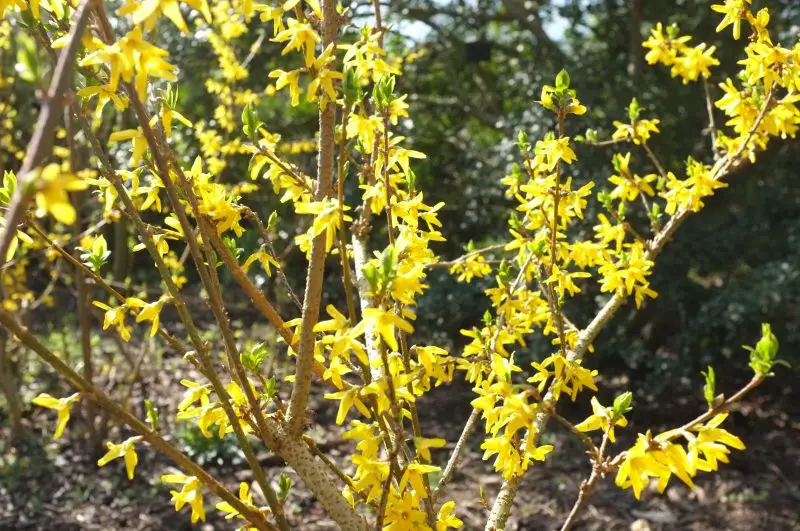
Forsythia is one of the earliest and most vibrant yellow-flowering shrubs in North America. Its arching branches burst into bright yellow blooms in early spring, often before the leaves appear, creating a dramatic display when most other plants are still dormant. It typically grows 6 to 10 feet tall with a wide, graceful spread.
The flowers are small, bell-shaped, and densely packed along the stems, giving the entire shrub a glowing yellow appearance. Bloom time is usually late March to early April, depending on the region. This makes forsythia a favorite for adding seasonal interest to gardens and borders.
Forsythia thrives in USDA hardiness zones 5 to 8. It prefers full sun for the best bloom production and well-drained soil. Pruning should be done right after flowering to maintain shape and encourage new growth. It is a low-maintenance plant, ideal for informal hedges or mass plantings.
Potentilla (Potentilla fruticosa)

Potentilla is a cold-hardy, compact shrub widely used in urban landscapes and residential gardens. It is especially valued for its long bloom season, producing bright yellow flowers from late spring through fall. This shrub typically grows 2 to 4 feet tall and forms a dense, mounded shape.
The flowers are small, five-petaled, and vividly yellow, often attracting pollinators such as bees and butterflies. Because of its extended flowering period and low maintenance needs, Potentilla is a popular choice for borders, foundation plantings, and mass groupings.
It performs best in USDA hardiness zones 3 to 7. Potentilla prefers full sun but can tolerate partial shade, and it thrives in well-drained soil. It is drought-tolerant once established and requires only occasional pruning to remove old stems and encourage new blooms.
St. John’s Wort (Hypericum spp.)
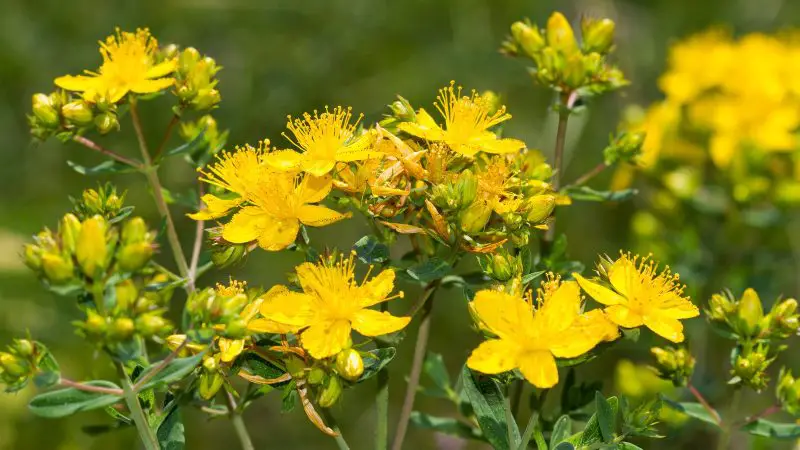
St. John’s Wort is a low-growing, versatile shrub with cheerful yellow flowers that bloom in early to mid-summer. The plant is well-known for its adaptability and is often used in ecological restoration projects and low-maintenance landscape designs. Most varieties reach 2 to 3 feet in height with a spread of similar size.
Its flowers are typically cup-shaped and bright yellow with prominent stamens, giving them a fuzzy appearance. Bloom time varies by species but generally occurs from June to August. The plant may also produce colorful berries in fall, adding to its ornamental appeal.
St. John’s Wort grows well in USDA zones 5 to 9. It tolerates a wide range of soils and light conditions, including full sun to part shade. This shrub requires minimal care, thrives in dry to moderate moisture conditions, and is deer-resistant, making it a dependable choice for naturalized areas.
Witch Hazel (Hamamelis virginiana & hybrids)
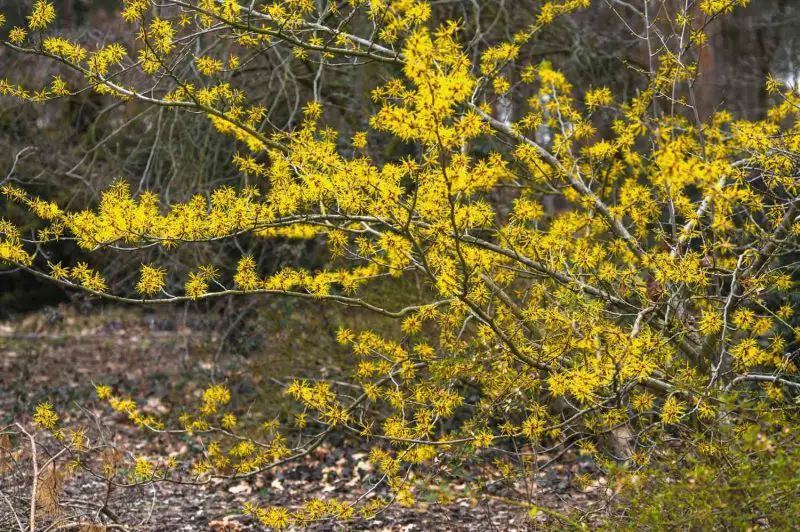
Witch Hazel is a unique deciduous shrub known for its late-season flowering. Native species and hybrids produce crinkled, spidery yellow blooms in late fall or even mid-winter, often when snow is still on the ground. This unusual bloom time makes it a standout in cold-climate gardens.
The fragrant yellow flowers appear along bare branches, adding winter interest to landscapes. Depending on the variety, blooming may occur from October through February. In fall, its foliage also turns golden, further enhancing its seasonal beauty.
Witch Hazel thrives in USDA zones 3 to 8. It prefers well-drained, slightly acidic soil and partial shade but can adapt to full sun. Regular watering and occasional mulching help retain moisture, though it is relatively low-maintenance once established.
Golden Currant (Ribes aureum)
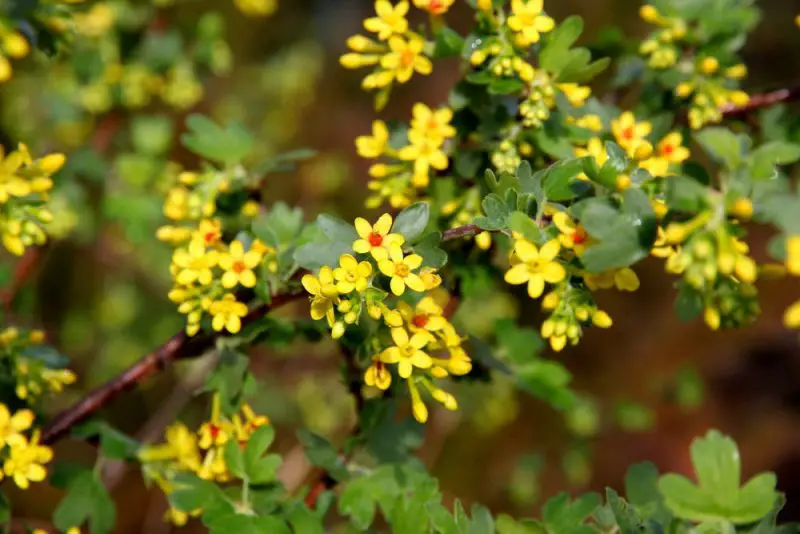
Golden Currant is a native North American shrub popular in western U.S. gardens for its bright yellow, clove-scented flowers and edible fruit. It typically grows 3 to 6 feet tall and has an upright, open form, making it suitable for wildlife gardens or native plant landscapes.
The tubular yellow flowers bloom in spring and attract hummingbirds, bees, and butterflies. Later in the season, the plant produces small black or reddish berries that are edible and often used in jellies or pies. Its foliage may turn red or orange in fall, offering multi-season appeal.
Golden Currant grows well in USDA zones 4 to 8. It prefers full sun to part shade and well-drained soils but is highly adaptable and drought-tolerant. It requires little pruning and benefits from occasional deep watering during dry periods.
Mahonia (Mahonia aquifolium – Oregon Grape)
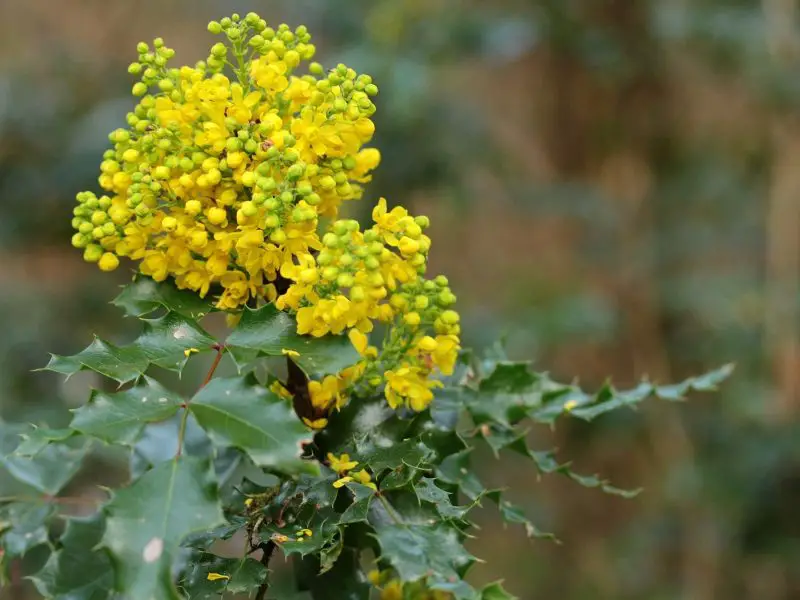
Mahonia, commonly known as Oregon Grape, is an evergreen shrub native to the Pacific Northwest of the United States. It is well-known for its bright yellow flowers that bloom in late winter to early spring, providing color when few other plants are in bloom. The plant grows 3 to 6 feet tall, with spiny, holly-like leaves that remain attractive year-round.
The yellow flowers are small and clustered in dense, upright spikes, which are followed by blue-black berries in the summer. These berries are not only ornamental but also edible, although they are tart and typically used in jellies or jams. In fall, the foliage can turn shades of red and purple, adding to the plant’s visual interest.
Mahonia thrives in USDA hardiness zones 5 to 9 and prefers partial to full shade. It does well in moist, well-drained soil and can tolerate drought once established. This shrub requires little maintenance, though pruning is recommended after flowering to keep it neat and promote air circulation.
Kerria (Kerria japonica)
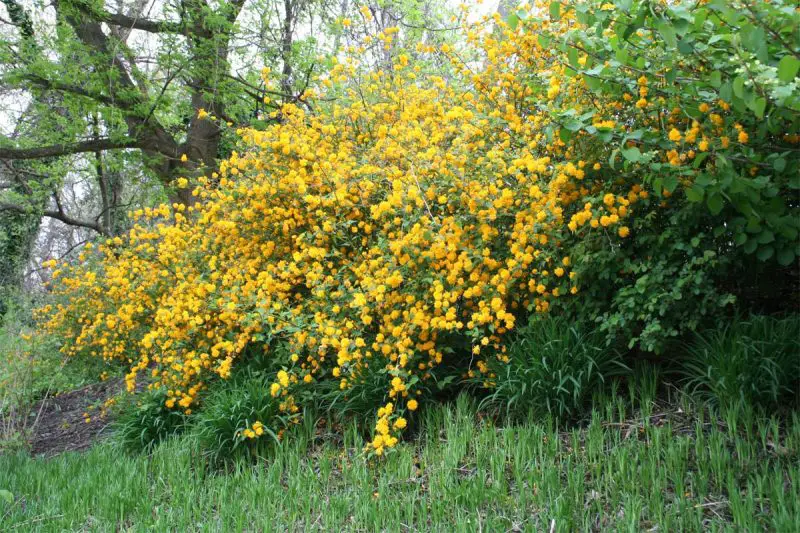
Kerria, or Japanese Rose, is a deciduous shrub that is widely planted for its vibrant yellow flowers and long blooming season. Native to East Asia, it has become a popular ornamental shrub in the eastern United States. Kerria typically grows 3 to 8 feet in height and spreads easily with a dense, arching growth habit.
The bright yellow flowers of Kerria are single or semi-double, resembling small roses, and bloom profusely in early spring. The plant continues to produce flowers intermittently through the summer. Its green stems are another distinctive feature, often turning yellow in winter, which adds to its year-round appeal.
Kerria grows well in USDA zones 4 to 9 and thrives in partial shade to full sun. It prefers moist, well-drained soil but is adaptable to various conditions. Pruning should be done after the flowering period to maintain shape and remove old stems, ensuring healthy growth the following year.
Yellow Roses (Rosa spp.)
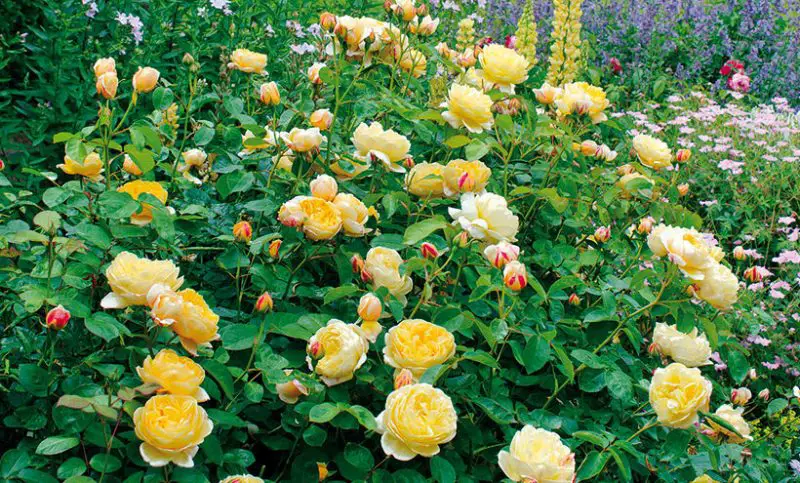
Yellow roses are a favorite among gardeners for their cheerful color and symbolism. Several yellow-flowering rose varieties, such as ‘Yellow Submarine’ and ‘Sunsprite,’ are particularly popular in North American gardens. These roses vary in size, from compact bush types to taller, climbing varieties, and they typically grow between 2 to 5 feet tall.
The yellow flowers can range from pale buttery hues to rich golden shades, often with a fragrant aroma. Roses bloom from late spring to early summer, and in some varieties, a second bloom can occur in fall. Their vibrant yellow petals make them a striking addition to flower beds, hedges, or as stand-alone specimens.
Yellow roses perform best in USDA zones 5 to 9 and prefer full sun for optimal blooming. They thrive in well-drained, slightly acidic soil and need regular watering, especially in dry periods. Pruning in early spring helps maintain shape and encourages more abundant blooms.
Butterfly Bush ‘Sungold’ (Buddleja x weyeriana ‘Sungold’)
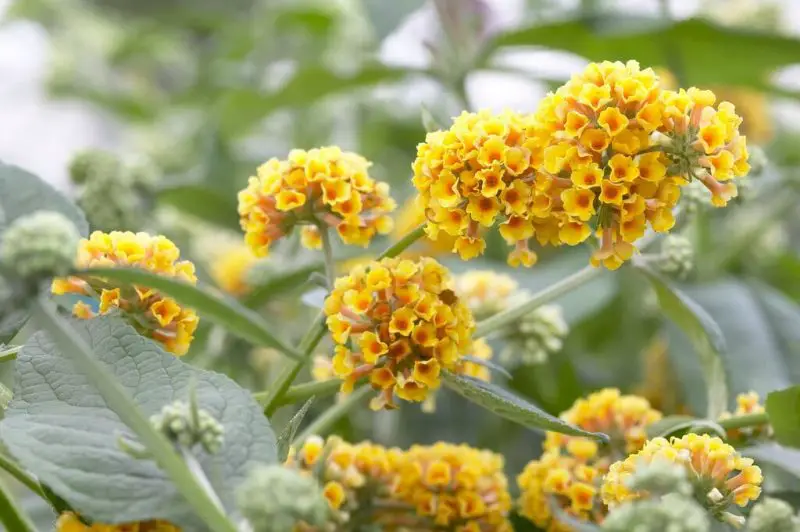
The ‘Sungold’ variety of Butterfly Bush is known for its bright yellow, fragrant flowers that attract butterflies and other pollinators. This cultivar grows to about 5 to 6 feet tall and has an upright, arching form. It is widely appreciated for its long flowering season, typically from summer to fall.
The flowers of ‘Sungold’ are small, tubular, and arranged in dense panicles. They emit a sweet fragrance, further enhancing their appeal to pollinators. As the blooms mature, they often attract a variety of butterflies, making this shrub a favorite for wildlife gardens and butterfly habitats.
‘Sungold’ Butterfly Bush thrives in USDA zones 5 to 9 and prefers full sun. It grows best in well-drained, moderately fertile soil and is relatively drought-tolerant once established. Regular pruning after blooming helps to maintain a compact shape and encourages more flowers the following season.
Scotch Broom (Cytisus scoparius)

Scotch Broom is a hardy, deciduous shrub commonly found in dry, well-drained soils, especially in the western United States. It grows 3 to 6 feet tall and has an upright, open habit with narrow, green leaves. The shrub is known for its profuse yellow flowers that bloom in spring, brightening up dry or rocky landscapes.
The yellow flowers of Scotch Broom are pea-shaped and appear in clusters along the branches. The blooms are fragrant and last for several weeks, attracting bees and other pollinators. After flowering, the plant produces small, brown seed pods, which can be a nuisance if left unchecked.
Scotch Broom grows best in USDA zones 5 to 9 and prefers full sun and dry, sandy soil. It is highly drought-tolerant and thrives in poor, nutrient-deficient soils. However, it can become invasive in some regions, so it’s important to manage its spread by regularly removing spent flowers and seed pods.
Senna Shrub (Senna corymbosa)
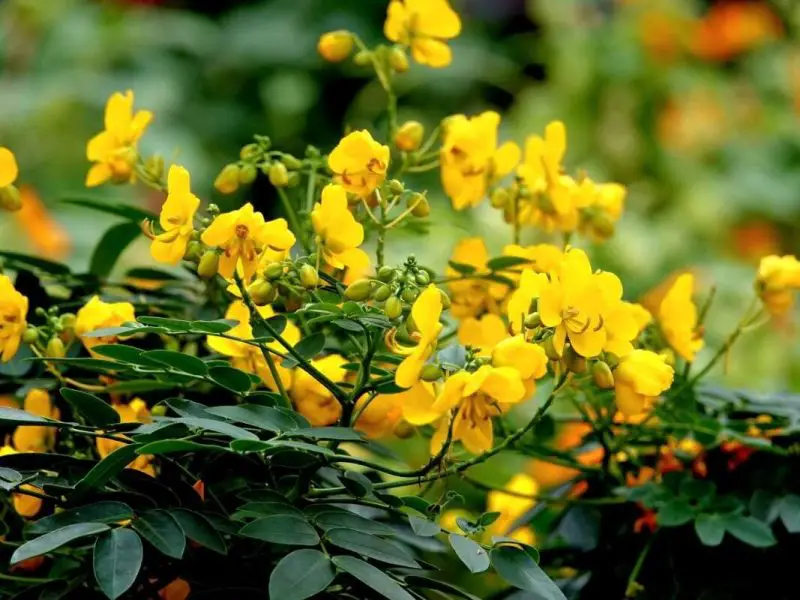
Senna Shrub is a tropical to subtropical plant native to the warmer regions of the United States, such as California, Arizona, and Texas. This shrub is renowned for its striking yellow flowers that bloom abundantly in the summer, making it a favorite in xeriscapes and low-maintenance gardens. It typically grows 3 to 6 feet tall with a rounded, bushy form.
The flowers are bright yellow, small, and grouped in clusters, attracting pollinators like bees and butterflies. The plant’s foliage is dark green, and it remains attractive even after the blooming period. The vibrant color of the flowers contrasts beautifully with the greenery, especially during the summer months when many other plants are less colorful.
Senna Shrub thrives in USDA hardiness zones 9 to 11, preferring full sun and well-drained, sandy soil. It is highly drought-tolerant once established and needs minimal care, making it an excellent choice for dry gardens or as a feature plant in desert landscapes. Regular pruning after flowering can help maintain its shape.
Yellow Azalea (Rhododendron luteum)
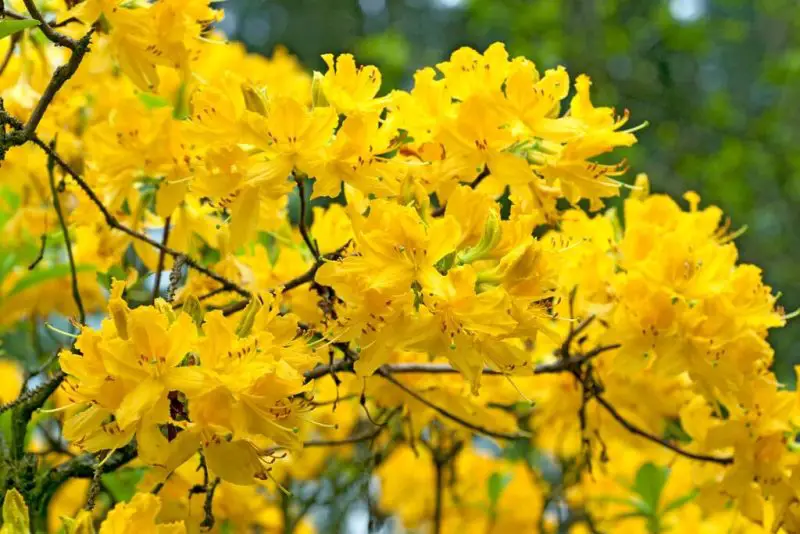
Yellow Azalea, also known as the Honeysuckle Azalea, is a deciduous shrub prized for its fragrant, yellow flowers. While it is not as commonly planted as its pink or white counterparts, it is still a popular choice in gardens in the Northeast and Southeast U.S. This azalea typically grows between 4 to 6 feet tall, with a compact, bushy shape.
The flowers of Yellow Azalea are trumpet-shaped and bloom in mid to late spring, adding a pop of bright yellow to the garden. The fragrance of the flowers is sweet and attractive to pollinators such as bees. The foliage is dark green, turning yellow or orange in the fall, which enhances the plant’s seasonal appeal.
Yellow Azalea thrives in USDA zones 5 to 8, preferring partial shade to full shade and moist, acidic soil. It is relatively easy to care for, requiring regular watering, especially in dry periods. Pruning is recommended after flowering to remove spent blooms and maintain the plant’s shape.
Texas Esperanza (Tecoma stans)

Texas Esperanza, also known as Yellow Trumpetbush, is a striking shrub native to the hot, arid climates of Texas, Arizona, and parts of Mexico. It grows 6 to 8 feet tall and has a spreading, open form, making it ideal for hedges or as a focal point in landscape designs. It is especially valued for its vibrant yellow, bell-shaped flowers.
The flowers of Texas Esperanza bloom in late spring to summer and are highly attractive to hummingbirds and butterflies. They are bright yellow with orange highlights, creating a vibrant display. The plant’s foliage is evergreen in warmer climates, providing year-round interest, though it may lose its leaves in colder regions during the winter months.
Texas Esperanza thrives in USDA zones 7 to 11. It prefers full sun and well-drained soil, making it perfect for xeriscapes or low-water gardens. This shrub is highly drought-tolerant once established and requires minimal care. Regular pruning after flowering helps promote new growth and maintain its shape.
Lydian Broom (Genista lydia)
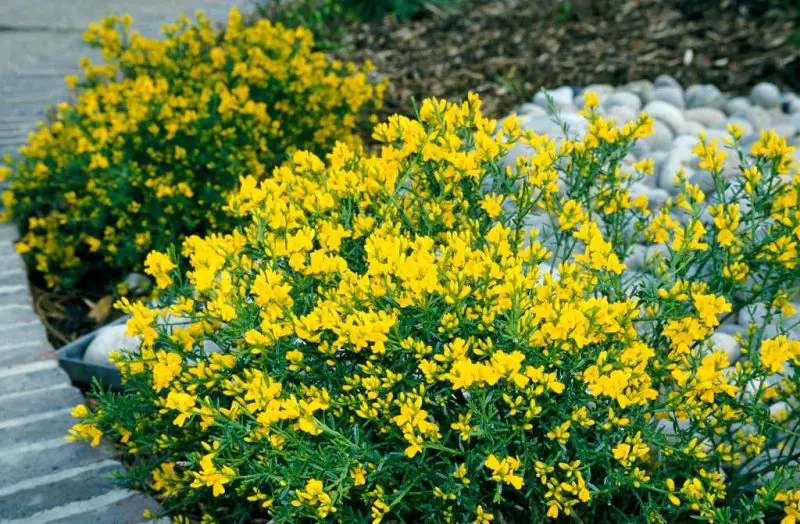
Lydian Broom is a compact, low-growing shrub that is known for its dense clusters of yellow flowers, which create a cheerful and vibrant display in the garden. It is commonly found in dry, rocky soils, especially in Mediterranean climates and dry landscapes. This shrub grows to about 2 to 3 feet in height and spreads wider than its height.
The yellow flowers of Lydian Broom are small and pea-like, blooming in abundance during late spring to early summer. They are attractive to bees and other pollinators. The plant has slender, green stems and small, fine leaves, which are characteristic of its broom-like appearance. Its compact size and dense flowering make it a popular choice for rock gardens or slopes.
Lydian Broom is suitable for USDA hardiness zones 5 to 9. It thrives in full sun and well-drained, dry soil. It is highly drought-tolerant and requires minimal maintenance. Pruning after flowering helps to keep the shrub tidy and prevent it from becoming leggy.
Winter Jasmine (Jasminum nudiflorum)
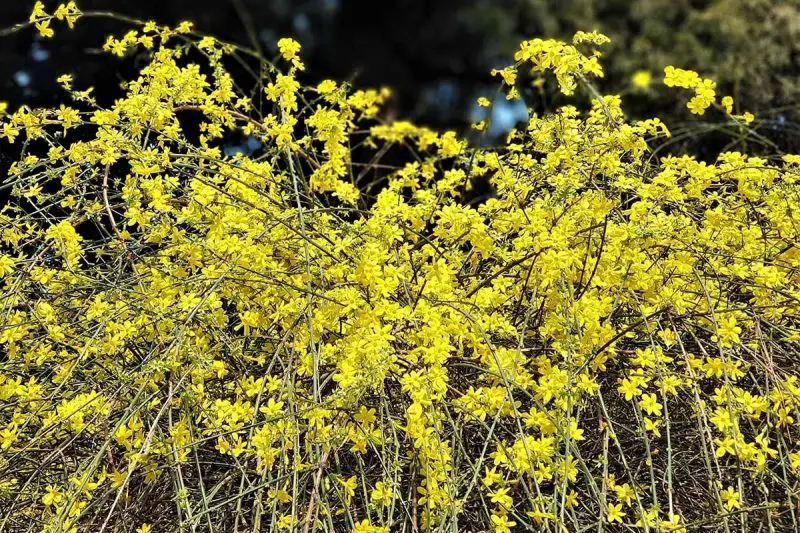
Winter Jasmine is a deciduous shrub that blooms in the winter to early spring, making it one of the first plants to add color to the landscape during the colder months. It is especially popular in the southeastern U.S., where it grows as a ground cover or climbing plant. The shrub grows 3 to 4 feet tall and spreads rapidly, creating a low, spreading form.
The yellow flowers of Winter Jasmine are small and star-shaped, blooming along the bare stems in late winter to early spring. The flowers appear before the leaves, offering a burst of cheerful color in otherwise bleak gardens. It is a favorite among gardeners looking to add early spring interest to their landscapes.
Winter Jasmine grows well in USDA zones 6 to 9, preferring full sun to partial shade. It is adaptable to a range of soil types but thrives best in well-drained, moderately fertile soil. Once established, it is relatively drought-tolerant and requires little maintenance. Regular pruning helps to shape the plant and promote more abundant flowering.
Dyer’s Greenweed (Genista tinctoria)
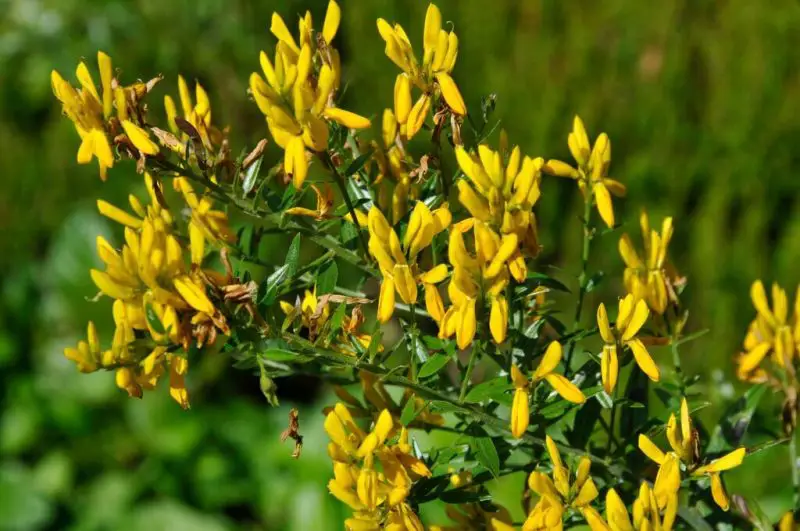
Dyer’s Greenweed is a lesser-known shrub often cultivated for its use in natural dyeing. It is typically found in native gardens or as part of traditional dye gardens. The plant has a compact form, growing around 2 to 3 feet in height, with bright yellow flowers that bloom in mid to late spring.
The flowers of Dyer’s Greenweed are small, pea-like, and appear in dense clusters. They are highly valued by those who practice natural dyeing because the plant’s flowers can be used to produce a yellow dye. The shrub’s foliage is green and feathery, providing an attractive backdrop for the vibrant yellow blooms.
Dyer’s Greenweed thrives in USDA hardiness zones 5 to 8 and prefers well-drained, sandy soils. It grows best in full sun and is relatively low-maintenance. Once established, it is drought-tolerant, though regular watering during dry spells encourages better flowering.
Berberis thunbergii ‘Aurea’ (Golden Japanese Barberry)
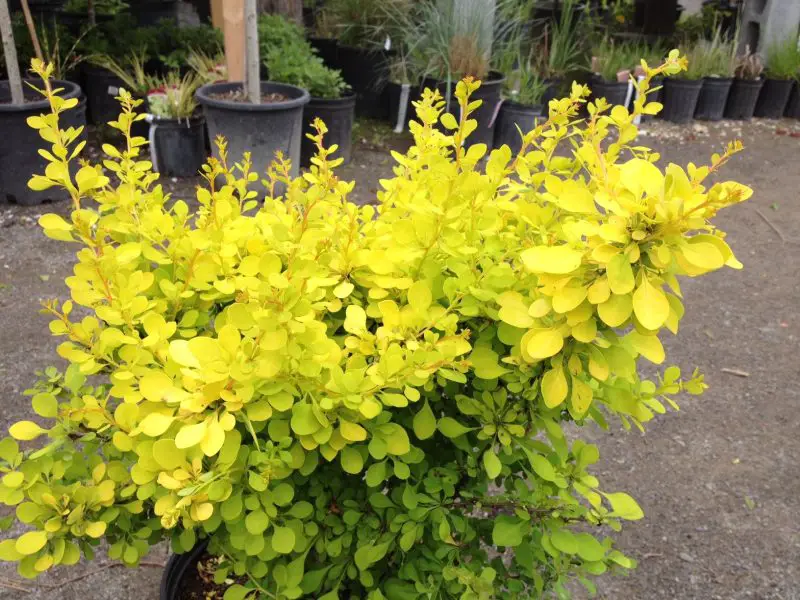
Berberis thunbergii ‘Aurea’ is a striking ornamental shrub known for its golden-yellow foliage rather than yellow flowers. This cultivar is particularly popular in landscape design for its vibrant, golden leaves that hold their color throughout the growing season. It typically grows to about 3 to 4 feet tall with a rounded shape.
While the flowers of the Golden Japanese Barberry are small and inconspicuous, the real attraction lies in its foliage, which ranges from yellow to chartreuse, depending on the amount of sunlight. In autumn, the leaves turn to rich shades of orange and red, adding to its seasonal appeal. Small red berries appear after flowering, offering additional interest in the fall.
Golden Japanese Barberry thrives in USDA hardiness zones 4 to 8. It prefers full sun to partial shade and can adapt to a variety of soil types, although it does best in well-drained, acidic soil. This shrub is low-maintenance, requiring only occasional pruning to maintain its shape.
Yellow Oleander (Thevetia peruviana)
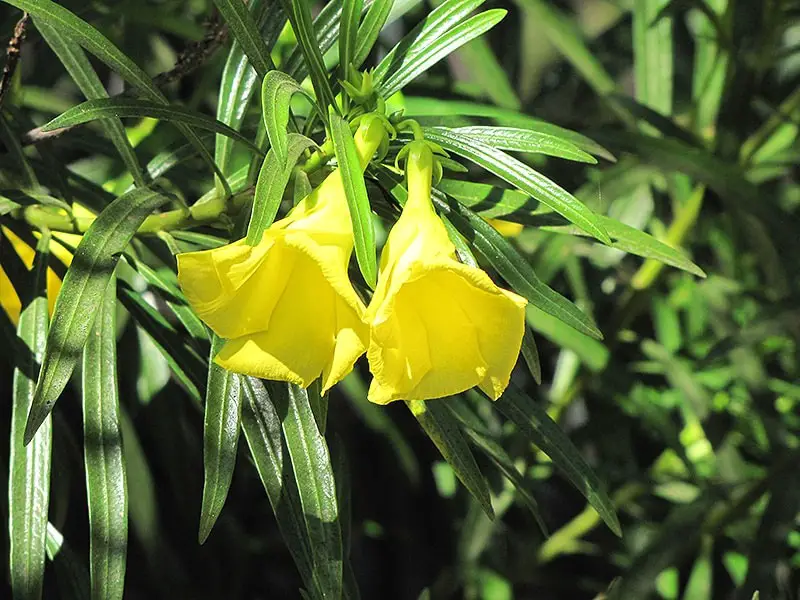
Yellow Oleander, although not as commonly planted due to its toxicity, can occasionally be seen in gardens in southern California and Florida. This shrub is native to tropical America and grows up to 10 feet tall. It has glossy, dark green leaves and large, bright yellow flowers that bloom during the summer months.
The flowers of Yellow Oleander are trumpet-shaped, with a deep yellow color that is eye-catching and fragrant. The plant is primarily used for ornamental purposes, though it should be handled with care, as all parts of the plant are toxic if ingested. The shrub is often found in coastal gardens and is used in landscaping for its bold color and dense foliage.
Yellow Oleander thrives in USDA hardiness zones 9 to 11, preferring full sun and well-drained, sandy soils. It is relatively low-maintenance and drought-tolerant once established. However, caution should be exercised when planting it in areas accessible to children or pets due to its toxic nature.
Cape Honeysuckle ‘Aurea’ (Tecomaria capensis ‘Aurea’)

Cape Honeysuckle ‘Aurea’ is a vibrant shrub with yellow-orange tubular flowers that are highly attractive to hummingbirds and butterflies. Although not native to the U.S., it is widely used as an ornamental shrub in warmer climates, especially in California and other southern regions. It can grow up to 10 feet tall and wide, making it an excellent choice for hedges or screens.
The flowers of Cape Honeysuckle ‘Aurea’ bloom throughout the warm months, typically from late spring to fall. The plant produces clusters of trumpet-shaped flowers that are bright yellow, adding a tropical flair to any garden. Its dark green foliage contrasts beautifully with the colorful blooms, and it has a sprawling, bushy growth habit.
Cape Honeysuckle ‘Aurea’ thrives in USDA hardiness zones 9 to 11. It prefers full sun and well-drained, slightly acidic soil. Once established, it is relatively drought-tolerant and needs minimal care, though regular pruning helps to maintain its shape and encourage more flowering.
Justicia aurea (Golden Shrimp Plant)
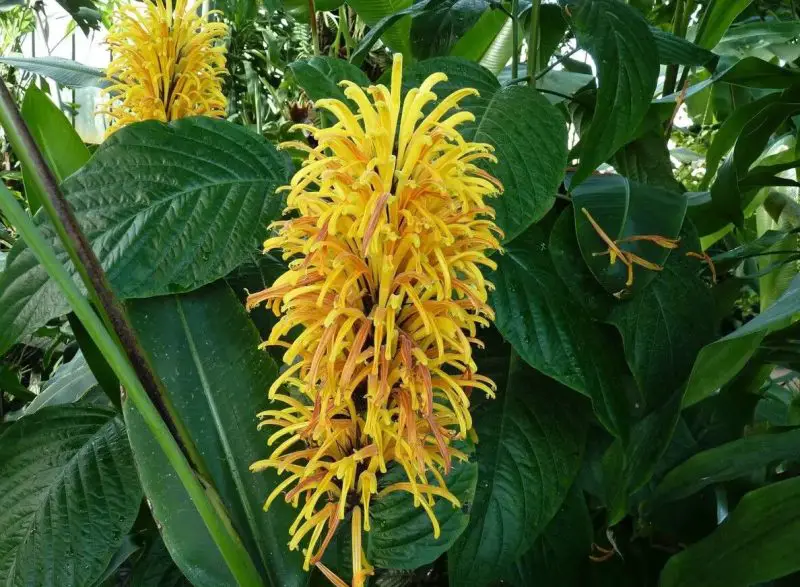
Justicia aurea, also known as the Golden Shrimp Plant, is a unique shrub that produces golden-yellow, shrimp-like flowers. It is mainly grown in southern Florida and used in containers or as a houseplant in colder regions. The plant grows to a height of 3 to 4 feet, with a spreading, bushy form.
The flowers of the Golden Shrimp Plant are cone-shaped, with a yellowish hue that resembles shrimp, hence the name. They are arranged on long, upright spikes, surrounded by dark green, glossy foliage. The blooms attract hummingbirds and butterflies, making this plant a favorite among gardeners who want to add movement and color to their garden.
Justicia aurea thrives in USDA hardiness zones 9 to 11 and prefers partial shade to full sun. It requires well-drained soil and regular watering, especially during the growing season. It is often grown in containers in cooler climates, and it benefits from occasional pruning to promote new growth and more flowers.
Ericameria (Ericameria spp.)
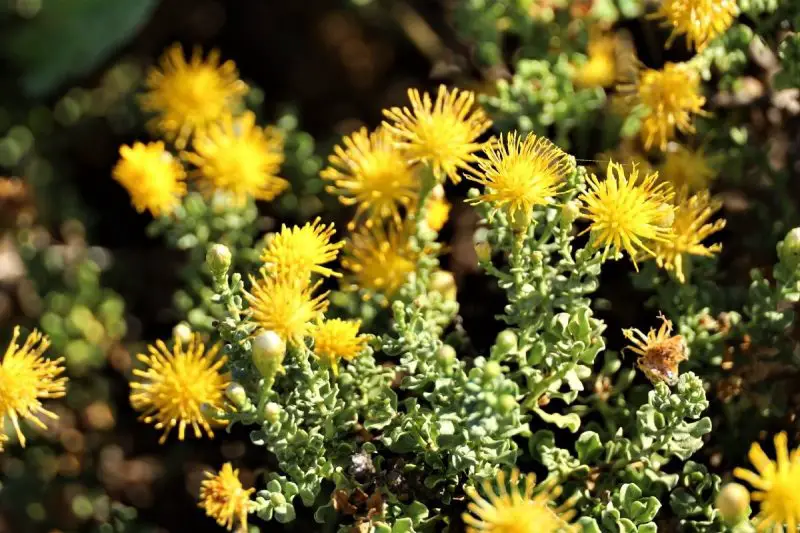
Ericameria, commonly known as goldenbush or rabbitbrush, is a shrub native to the western United States. Known for its striking yellow flowers, it blooms during the late summer, providing vibrant color in dry landscapes. This shrub typically grows to a height of 3 to 6 feet and has a bushy, compact form. Its narrow, silvery-green leaves create a lovely contrast against the bright yellow blooms.
The flowers of Ericameria are small and cluster together in dense panicles, creating a golden mass during late summer and early fall. These flowers attract pollinators such as bees and butterflies, making the shrub an excellent addition to pollinator-friendly gardens. After flowering, the shrub’s foliage turns a golden yellow in the fall, adding seasonal interest.
Ericameria thrives in USDA hardiness zones 4 to 9 and is well-suited to dry, well-drained soils. It prefers full sun and is highly drought-tolerant once established, making it an ideal choice for xeriscaping or low-maintenance landscapes. This shrub requires minimal care, though occasional pruning helps to maintain its shape and promote healthier growth.
Bush Honeysuckle (Diervilla spp.)
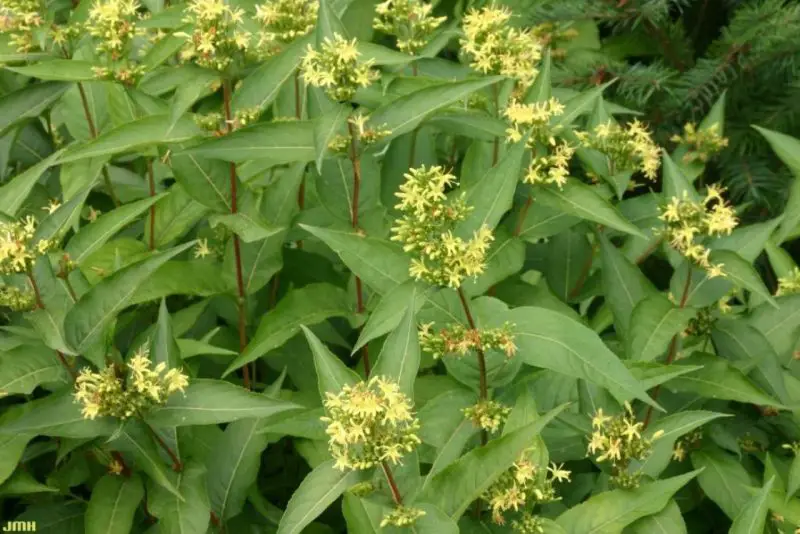
Bush Honeysuckle is a hardy, deciduous shrub native to North America. Known for its bright yellow flowers that bloom in late spring to early summer, it’s commonly found in natural landscapes and garden borders. The shrub grows to a height of 3 to 5 feet and has an upright, spreading habit, making it a versatile addition to many garden designs.
The flowers of Bush Honeysuckle are trumpet-shaped and appear in clusters, attracting pollinators such as hummingbirds and butterflies. The shrub’s green foliage turns reddish in the fall, offering additional seasonal interest. Bush Honeysuckle is also known for its resistance to pests and diseases, making it an excellent choice for low-maintenance landscapes.
Bush Honeysuckle thrives in USDA hardiness zones 4 to 8 and can adapt to a wide range of soil types, from well-drained sandy soils to moist, clay-heavy soils. It prefers full sun but can tolerate partial shade. This shrub is drought-tolerant once established and requires minimal care, although occasional pruning will encourage better flowering and maintain its shape.
Edgeworthia chrysantha (Paperbush)

Edgeworthia chrysantha, also known as Paperbush, is a deciduous shrub known for its fragrant yellow flowers that bloom in late winter to early spring. Native to China and Japan, it has become popular in southern U.S. gardens due to its unique appearance and early-season color. This shrub typically grows to about 4 to 6 feet in height and has an elegant, arching form.
The flowers of Paperbush are small, fragrant, and cluster together in dense, ball-shaped clusters. Their bright yellow color provides a cheerful contrast against the otherwise bare winter landscape. After blooming, the shrub’s green leaves emerge in spring, and it continues to provide interest throughout the growing season. Paperbush is a favorite in botanical gardens and ornamental landscapes for its early blooms and striking fragrance.
Edgeworthia chrysantha thrives in USDA hardiness zones 7 to 9 and prefers well-drained, slightly acidic soil. It thrives in partial shade to full sun and should be watered regularly during dry spells. Paperbush benefits from occasional pruning to remove any dead or damaged growth, and it is generally low-maintenance once established.
Gold Mop Cypress (Chamaecyparis pisifera ‘Golden Mop’)
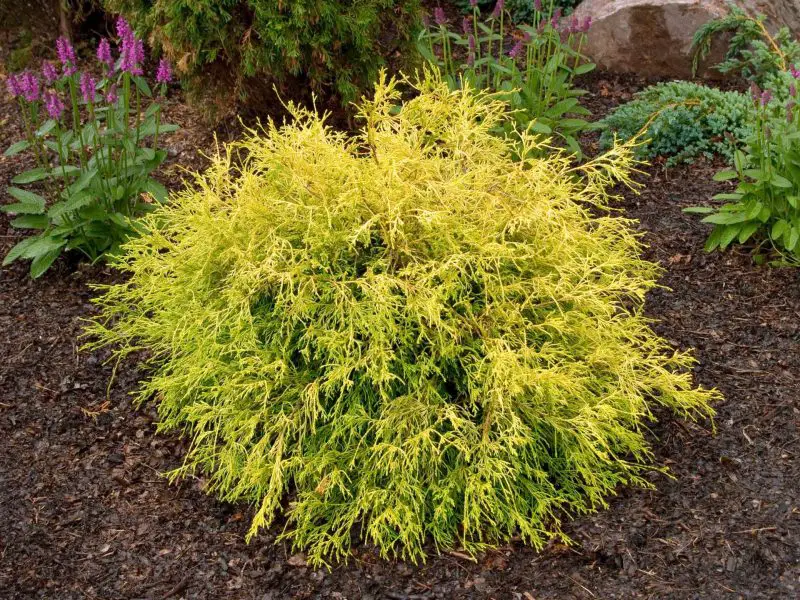
The Gold Mop Cypress is a compact, evergreen shrub known for its striking golden-yellow foliage. It typically grows to about 3 to 4 feet in height and spreads out to 4 to 5 feet wide, making it a great addition to smaller gardens or as a focal point in larger landscapes. Its bright golden leaves provide year-round interest, especially in the winter months when many other plants lose their color.
The Gold Mop Cypress has a unique, feathery texture, and its vibrant yellow foliage creates a dramatic contrast against darker green plants. This shrub is ideal for adding visual interest to gardens, and it often works well in both formal and informal settings. In addition to its visual appeal, the Gold Mop Cypress also thrives in well-drained soils and is highly resistant to pests and diseases.
Gold Mop Cypress thrives in USDA hardiness zones 4 to 8 and prefers full sun to partial shade. It requires regular watering during dry spells but is otherwise drought-tolerant once established. This shrub is low-maintenance, but occasional pruning helps to maintain its shape and prevent overgrowth.
Carolina Jessamine (Gelsemium sempervirens)
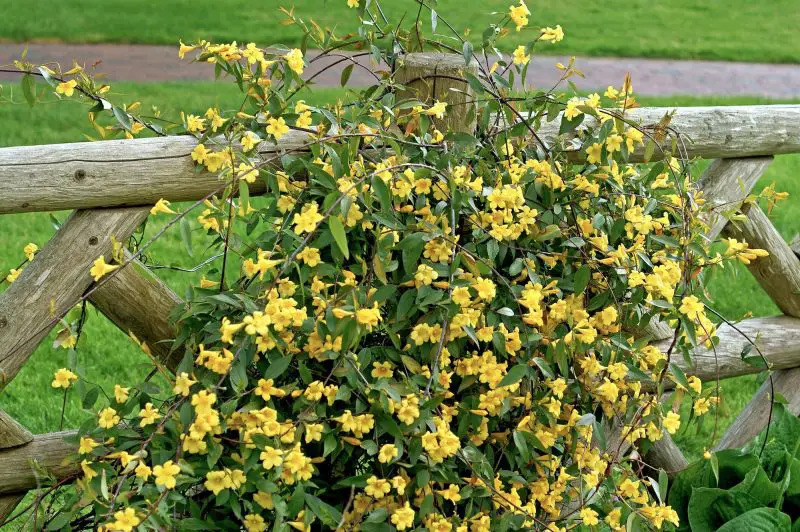
Carolina Jessamine is a fragrant, yellow-flowering vine native to the southeastern United States. Known for its bright, trumpet-shaped flowers, it is often used as a climbing vine or groundcover in both formal and informal landscapes. This vine can grow up to 20 feet in length, making it an excellent choice for covering fences, trellises, or walls.
The flowers of Carolina Jessamine are a rich yellow color and emit a sweet, pleasant fragrance, which makes it a popular choice for garden trellises and entryways. The glossy, dark green foliage provides a beautiful backdrop to the yellow blooms, and it maintains its appearance throughout the year. In mild winters, Carolina Jessamine can bloom as early as late winter, adding much-needed color and fragrance to the garden.
Carolina Jessamine thrives in USDA hardiness zones 7 to 9 and prefers full sun but can tolerate partial shade. It grows best in well-drained, slightly acidic soils and should be watered regularly during dry periods. This vine is relatively easy to care for and benefits from occasional pruning to maintain its shape and encourage fuller growth.
Genista tinctoria ‘Golden Fleece’
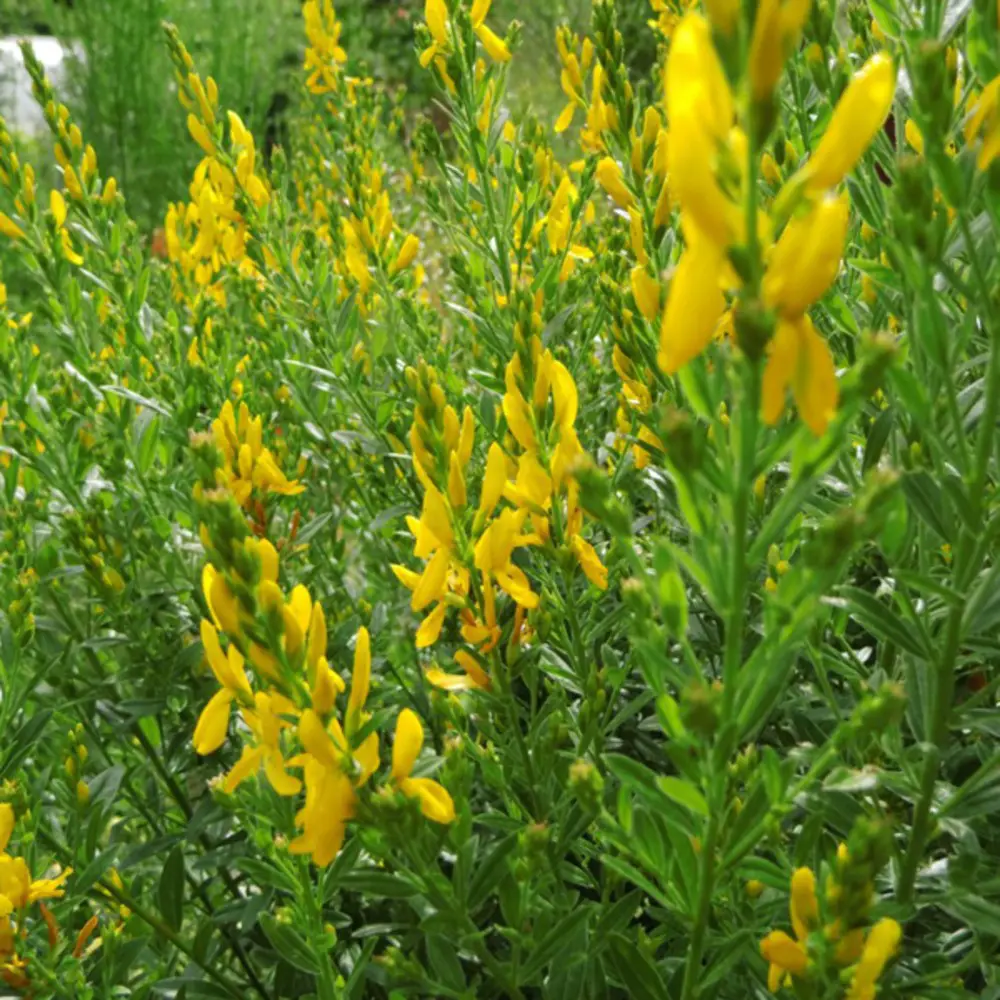
Genista tinctoria ‘Golden Fleece’ is a compact, low-growing deciduous shrub known for its striking golden-yellow flowers and fine-textured green foliage. It typically grows to about 1 to 2 feet tall and spreads up to 3 feet wide, forming a tidy mound. This cultivar is prized for its neat growth habit and its ability to bring bright color to rock gardens, borders, or slopes.
The flowers of ‘Golden Fleece’ are small, pea-like, and vividly yellow, blooming profusely in late spring to early summer, typically from May to July. The blooms often cover the plant so densely that the foliage nearly disappears beneath the golden display. These cheerful flowers are attractive to bees and other pollinators, making the plant a valuable addition to wildlife-friendly gardens.
Hardy in USDA zones 4 through 8, Genista tinctoria ‘Golden Fleece’ prefers full sun and well-drained, sandy or loamy soil. It is drought-tolerant once established and requires little maintenance beyond occasional pruning to shape or remove spent growth. Avoid rich or overly wet soils, as these can reduce flowering or lead to root rot.
Chilean Jasmine (Mandevilla laxa)
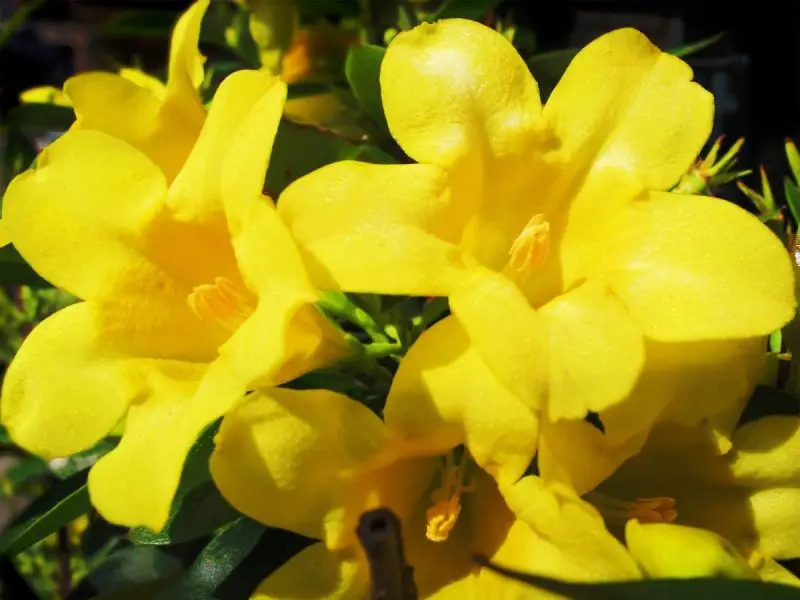
Chilean Jasmine, also known as “Lady of the Night,” is a fragrant, yellow-flowered vine native to South America. This tropical vine is known for its bright, tubular yellow blooms that appear from spring to fall. It is widely used in southern gardens and is often grown on trellises, arbors, and fences for its fragrant flowers and fast-growing nature.
The flowers of Chilean Jasmine are trumpet-shaped, with a creamy yellow color and a sweet fragrance that is most noticeable at night. The vine has glossy, dark green foliage that provides an attractive backdrop for the yellow flowers. It is often used in landscape designs to cover unsightly structures or as a fragrant focal point.
Chilean Jasmine thrives in USDA hardiness zones 9 to 11 and requires full sun to bloom best. It prefers well-drained, fertile soils and should be watered regularly, especially during hot, dry periods. This vine benefits from regular pruning to encourage new growth and maintain its desired size.
Yellow Bells (Tecoma stans)
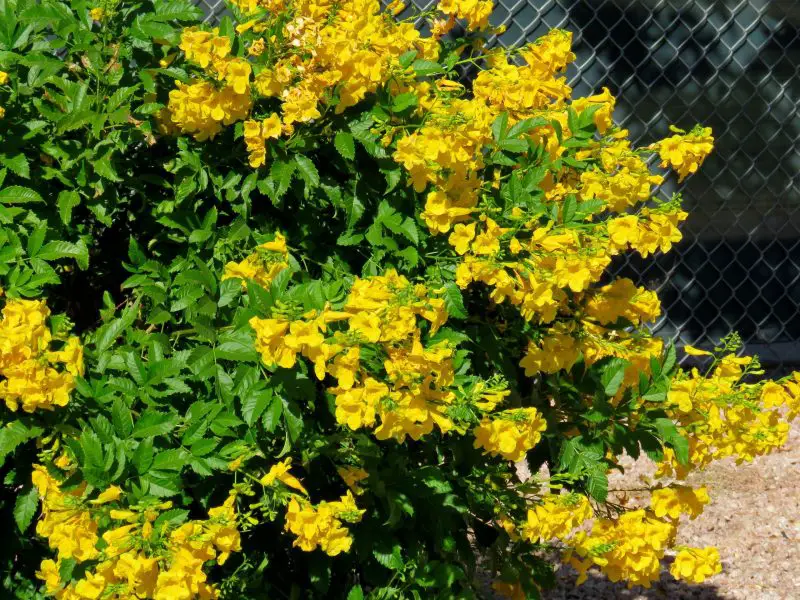
Yellow Bells, also known as Yellow Trumpetbush, is a fast-growing, tropical shrub that blooms with large clusters of trumpet-shaped yellow flowers in the summer. Native to the southwestern United States and Mexico, it is commonly used in xeriscaping and desert gardens due to its drought tolerance and striking flowers.
The yellow flowers of Yellow Bells attract hummingbirds and butterflies, making it a popular choice for pollinator gardens. The shrub’s dark green leaves provide a lovely contrast to the bright blooms, which can last from late spring through the summer. It is often used as a hedge or specimen plant.
Yellow Bells thrive in USDA hardiness zones 9 to 11 and prefer full sun and well-drained soils. This shrub is highly drought-tolerant once established and requires minimal care, though occasional pruning can help keep its shape.
Yellow Cestrum (Cestrum aurantiacum)
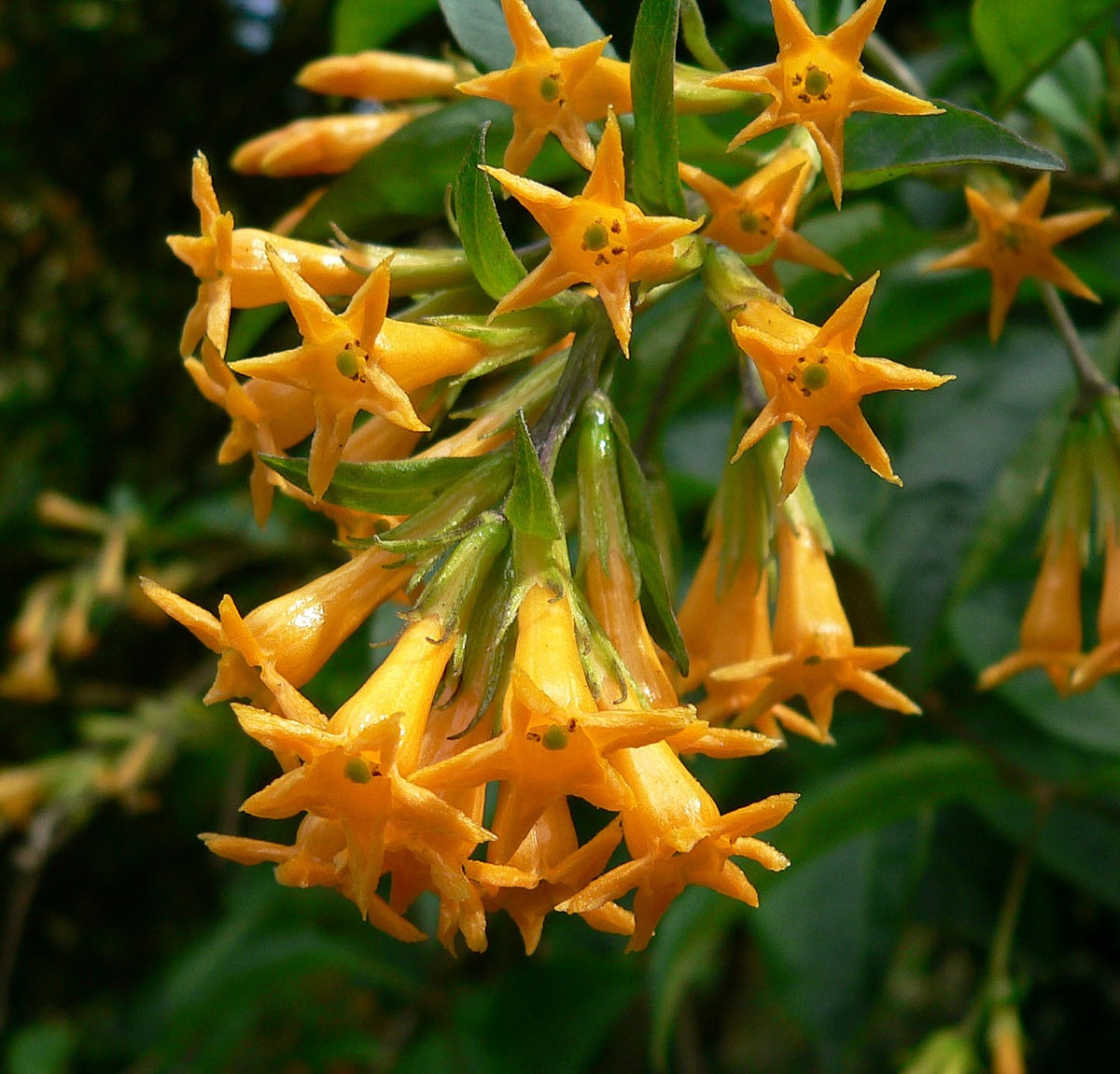
Yellow Cestrum, also known as the “Day-Blooming Jasmine,” is a tropical shrub that features clusters of small, yellow tubular flowers that are intensely fragrant. Native to the Caribbean and parts of Central and South America, it is frequently grown as an ornamental shrub in warm climates.
The small yellow flowers bloom in clusters and emit a sweet fragrance that is strongest during the night. While the flowers only last a few days, the plant blooms profusely from spring through fall. It is an excellent choice for attracting pollinators like bees, butterflies, and hummingbirds.
Yellow Cestrum thrives in USDA hardiness zones 9 to 11 and prefers full sun to partial shade. It grows best in well-drained soils and requires regular watering during hot months. However, it does not tolerate frost and may need protection or to be brought indoors in cooler climates.


